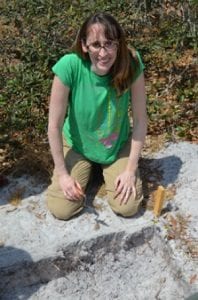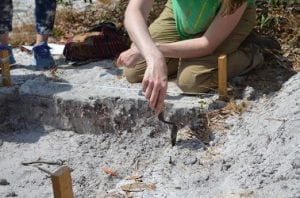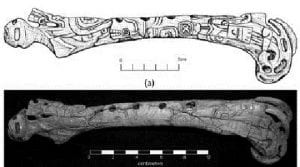UCF Archaeologist Featured on NPR

UCF Mesoamerican archaeologist, Sarah “Stacy” Barber, Ph.D., was recently interviewed on NPR’s Marketplace Morning Report by David Brancaccio. In his series known as the, Pro Tool: Tools Of The Professional, Dr. Barber discussed the importance of a Marshalltown trowel; an excavation tool she often uses in her profession. The Pro Tool series explores the must-have devices in different professions acclaimed by experts in the field. Dr. Barber’s interview titled, “Unearthing the past with a piece of history: An archaeologist and her trowel” aired on May 18, 2016.

Barbara using her “Pro Tool,” the Marshalltown trowel.
“Archaeologists — we respect history and tradition. The Marshalltown has been employed by archaeologists in the field since at least the early 20th century,” explained Dr. Barber. “That’s the brand that the greats would have used — the archaeologists who inspired ‘Indiana Jones’.”

One of Barber’s favorite finds was a flute (pictured above) made out of a deer’s femur about 2,000 years ago. She found it buried with the remains of a 16-year-old from the same time period in Oaxaca, Mexico
Dr. Barber’s research focuses on the ways that religion and long-distance economic interaction have shaped urban societies in southern Mexico. She seeks to understand the various processes that enabled and constrained the development of the first cities. Her published research has included geospatial modeling of trade routes, music archaeology, geophysical remote sensing, and broader examinations of political change in ancient Oaxaca, a state in southern Mexico. Additionally, her fieldwork in countries such as El Salvador, Honduras, and Mexico includes archaeological excavation, survey, mapping, and ground penetrating radar (GPR).
When asked by Brancaccio the coolest artifact she has found, Dr. Barber replied,“The coolest thing I found was a flute made of a deer bone that was carved with the image of, likely, the God who was summoned when the flute was played. So, it’s this guy with a skeletal body and he’s got a long top knot hair sort of ponytail coming down his back. The holes of the flute are eyeholes of his skull in the carving.”
With a passion for her innovative research in the Pacific coast of Oaxaca, Dr. Barber is excited to continue her archeological work in Mexico.
To listen to the full audio recording of Dr. Barber’s interview, click here.
